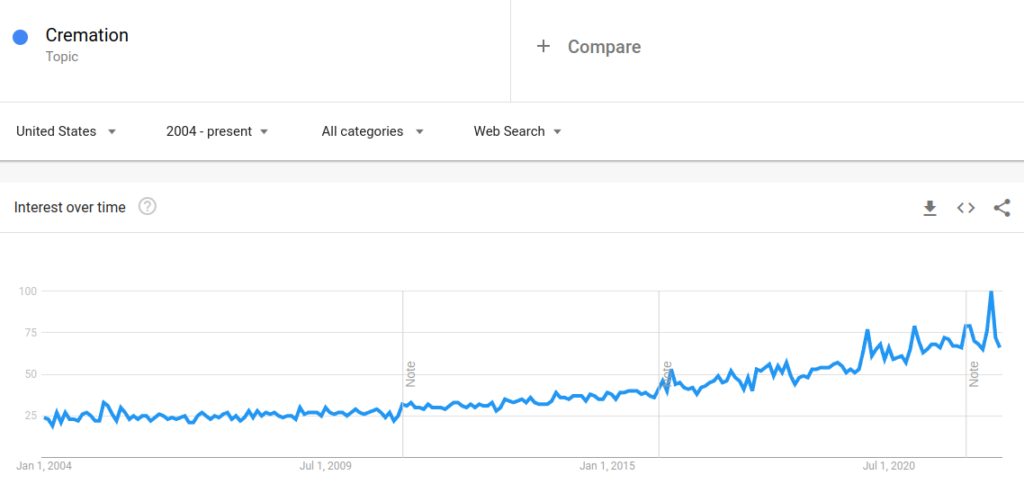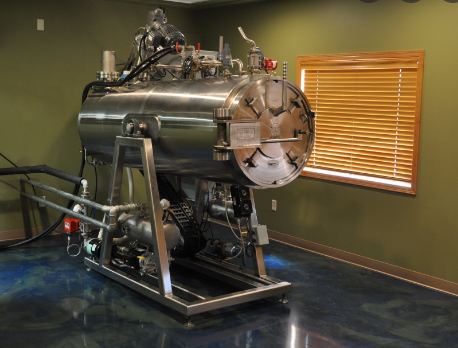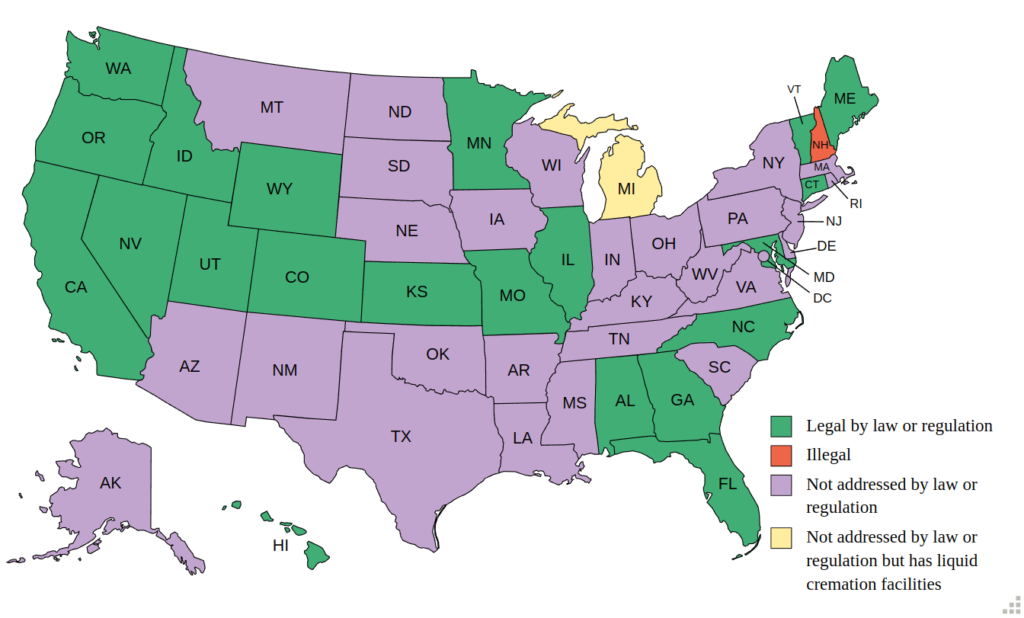It costs $9,900 to die in the United States. That’s the national median funeral cost including burial in 2022.
For that price, you get a $2,500 casket, a $2,000 burial plot, $775 of embalming services, and $4,625 of miscellaneous fees that are mostly hot air. Since hot air has great margins and since the death rate isn’t reduced by recessions, funeral homes might seem like the perfect recession-proof business. In this article, I’m going to explain why they aren’t, but I’ll also tell you about two other death care businesses that are.
Why aren’t funeral homes recession-proof businesses?
Funeral homes make most of their money by selling caskets, transporting bodies, embalming & other “cosmetic body prep” services. If the funeral home owns the cemetery, it will also make money on selling you a grave plot, grave digging services, and a headstone.
All those big money makers are dependent on people getting buried. Unfortunately, burials have been consistently losing market share to cremations almost every year for the past several decades. In 2006, 33.8% of people who died in the U.S. were cremated. In 2011, 42% were cremated. In 2016, 50.1% were cremated. In 2021, 57.5% were cremated.
There are three main reasons for this ongoing shift in American consumer preferences.
- Cremation is cheaper than burial.
- There is less religious stigma against cremation today than there was 30 years ago. This is partly because some religions like Catholicism have embraced cremation as acceptable within the last few decades. It is also partly because a smaller percentage of Americans are religious today than were religious 30 years ago.
- Americans care more about environmental sustainability today than they did 30 years ago, and burials have a higher environmental cost than cremations.
As cremations continue to chew into the market share of burials, profit margins of funeral homes go down. That poses a headwind to the entire industry that will likely continue for decades.
To make matters worse (for the funeral industry), more and more Americans are opting for non-traditional “wakes” or “life celebrations” at home rather than somber, multi-hour ceremonies at funeral homes that charge a high hourly rate to use their space. This poses a second significant headwind to funeral home businesses.
Finally, a third headwind exists for funeral homes that own cemeteries with lots of unused plots. The decreasing rate of burials means that cemetery plots can stay empty for longer periods of time, and some may never be filled at all. Yet it’s difficult to sell unused parts of cemeteries, and if you can sell them at all it will be at a steep discount to other real estate nearby. That means many funeral homes are stuck with real estate assets that aren’t generating any income which brings down their rate of return-on-assets.
Fortunately, we’ve already seen an industry with all of the recession-resistance and none of the headwinds of funeral homes.
The economics of crematoriums

A crematorium is a body-disposal facility. Some are owned by funeral homes while others are independently operated and contract their services to one or more funeral homes. Given the headwind to on-site funeral home ceremonies discussed earlier, the best type of crematorium to start today would be a small facility which focused purely on cremations without taking on the overhead of large real estate spaces.

Alibaba currently has cremation machines (shown above) for sale for $45,000 plus shipping. You’ll also need a facility with appropriate ventilation for the fumes created by the machine.
Crematoriums are regulated at the state level, and most states will require that the individual operating a crematorium have a funeral directors license.
Crematoriums have a strong industry tailwind from the increasing popularity of cremation. Crematoriums are also incredibly recession-proof for two reasons:
- Overall death rate does not decrease during recessions.
- Cremation is cheaper than burial, so financially distressed families are even more likely to choose cremation than burial during recessions.
However, one of the current industry tailwinds of cremation has the potential to flip into a headwind: Environmentalism.
Cremations DO have a lower environmental cost than traditional burials. However, they still emit about as much CO2 as a 600 mile car trip, they are energy-intensive, and they can release toxic air pollution from the mercury in some dental fillings. That means that there is potential for a public backlash against cremations in the future. Additionally, some local governments have already temporarily suspended crematoriums’ ability to operate during times when air pollution is particularly bad. Fortunately, there is an newer alternative option: liquid cremation.
Liquid cremation: the perfect recession-proof business
Liquid cremation, wet cremation, water cremation, aquamation, flameless cremation, resomation, alkaline hydrolysis — these are all the same thing: Dissolving bodies in a 5% solution of potassium hydroxide at between 200-300 degrees Fahrenheit.

The process decomposes a body into a non-toxic solution of amino acids that can be processed by municipal water supply systems. I.e. it’s safe to dump the resulting liquid down the drain.
Metal implants are left intact and can be recycled. Bones are also left behind and can be ground into powder which is then returned to families in place of ashes from a traditional cremation.
Liquid cremation is completely sterile. The alkaline solution kills any pathogens and sterilizes the bones. That means there is no risk of diseases contaminating a water supply as there is with unembalmed burials. There is also no risk of carcinogenic embalming fluids contaminating a water supply as there is with embalmed burials. In fact, liquid cremation might be the best possible body disposal method because it is both highly sterile and very environmentally friendly. When compared against traditional cremation, three of the biggest environmental benefits are:
- Liquid cremation requires only 10-15% of the energy used by traditional cremation.
- Liquid cremation does not require combustion. All energy requirements can be met by cleanly produced electricity.
- Liquid cremation produces zero gaseous emissions. (In contrast, traditional cremations release CO2, carbon monoxide, mercury, or other combustion byproducts).
In addition to the environmental benefits, it takes the same amount of time to perform a liquid cremation as a traditional cremation. The cost to perform a liquid cremation can also be less than a traditional cremation, especially if energy prices are high.
How to start a liquid cremation business
Starting a liquid cremation business is in many ways easier than starting a traditional cremation business. Liquid cremation is still a new concept, and there are many fewer competitors offering the service (but Google search trends still show a growing interest in liquid cremation over the years). The machines required are also smaller & lighter than traditional cremation machines. However, since liquid cremation is so new, there are fewer suppliers so the machine are still more expensive ($150k-400k for a human-sized machine or around $60k for a pet sized aquamation machine).
If you’re an engineer, then selling glorified steel drums for hundreds of thousands of dollars is a business opportunity worth considering in itself. If you’re not an engineer, you can still start a liquid cremation business without a ton of money by either financing or leasing an aquamation machine.
When deciding on where to locate your business, you’ll have to consider the legal landscape. Twenty-one states have currently legalized liquid cremation, one state has made it illegal, and the remaining twenty-eight states are legally ambiguous with no law or regulation explicitly addressing the topic. The trend in general though is towards more and more states adding explicit provisions to legalize the process.

Liquid cremation for pets however is legal in every state.
Subscribe to the Axiom Alpha Letter to get articles like this straight to your inbox every week!